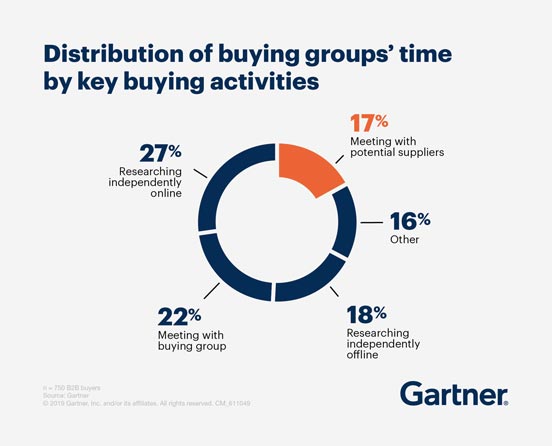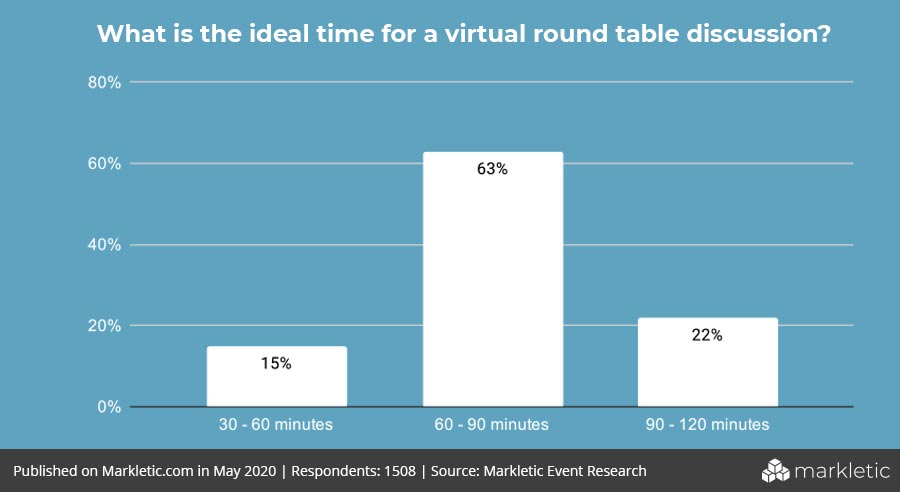How to Host a Virtual Roundtable Discussion That Converts

Table of Contents
Senior decision-makers want to discuss business challenges with people at the same executive level. Hosting a virtual roundtable discussion is an excellent way to accommodate this need. After a successful virtual roundtable discussion, the audience will walk away inspired and with actionable strategies.
The B2B buying process is complex, especially when it comes to big transactions. Gartner’s research shows that 27% of the full buying process is spent on independent research online.

However, in this day and age, the amount of information on the internet is massive. In fact, it’s quite overwhelming.
That’s why senior decision-makers want to talk about business challenges with people at their level and in their market. Those other executives have been there before. They’ve got the proven experience to have a meaningful conversation about certain business challenges. This is what is valuable for C-level executives.
A virtual roundtable is an excellent way to facilitate executive-level discussions. And, to be honest, hosting a virtual roundtable is not rocket science. There are plenty of tools that you can use to facilitate this. You can set up one tomorrow if you like.
The challenge is getting senior decision-makers to attend your virtual roundtable. This all starts with your own mindset and the strategy that you have to make the virtual roundtable successful.
C-level people are at that position for a reason. They’re intelligent and seasoned. With the slightest smell of a sales pitch or a marketing story, they will bail.
You need to set up the roundtable with the single goal of delivering value for your audience. This is the only way that C-level executives will make time for your event.
So in this article, I’ll help you by showing you how you can host a virtual roundtable discussion that senior executives actually will attend.
1. Define the objectives for your company and the audience
If you want to host a successful virtual roundtable discussion, then you must have your audience in mind from the get-go. How are you going to provide value for them?
Of course, you also have your own objectives. Start by understanding what problem you are trying to solve with this virtual roundtable. The most common reason is to generate new pipeline for your sales team. It’s the ultimate goal.
You need to define your success metrics from the beginning and validate these with your local sales directors. This will create buy-in from sales, which will make them more motivated to invite their connections to the virtual roundtable.
When defining your objectives for the virtual round table, ask yourself questions such as:
- How many registrations will we need to achieve our target attendance number? Consider a no-show rate of about 20-30%.
- How will we make it interactive? Tip: I've written an article with 5 virtual event engagement ideas.
- What are our call-to-actions from the roundtable discussion?
- What metrics do we need to achieve for us to call the event successful?
- What’s a relevant topic that our target audience would want to talk about?
At this stage, you really need to define the objectives for the audience. What are they going to get out of it? Why should they attend?
If you don’t have this in mind from the get-go, then it will be impossible to create the right messaging and promotion plan that will convert.
You will start making concessions and accept a lower level audience. The round table will lose its value and your sales team will be disappointed. Nobody wants this.
I've written an article with 8 Tips on how to perfect your virtual event marketing plan.
2. Selecting the topic for the virtual roundtable discussion
Without the right topic, the audience is not going to register for your roundtable. You need to find a topic that is relevant and that your audience wants to discuss.
Finding the right topic might be hard. However, you can always ask your sales team for feedback about what they see in the market.
When selecting a topic, keep your target audience in mind. What topics would cause them to attend this roundtable? What’s valuable for them?
Of course, you also need to align the topic with what your company can offer. At the end of the day, you want to provide the audience with inspiration on how they can solve critical issues with your solutions.
If you are selling marketing software, it wouldn’t make much sense to host a virtual round table about accounting best practices.
A virtual roundtable provides a unique opportunity for the audience to connect with people at the same level. So think of topics that your target audiences want to discuss with people from the same level.
Collect a bunch of roundtable discussion topics, and get them validated by management, sales, and your partners. Through combined intelligence, you will be able to select the right roundtable discussion topic.
3. Decide on the right format
The format of a virtual roundtable is crucial to its success. The duration of the roundtable discussion should be between 60 and 90 minutes. Any longer, and it will be too much of a drain on the audience.

In addition, it’s much easier for C-level executives to free up an hour on their agenda rather than 3 hours.
For the sake of this example, let’s say you are going to host a virtual roundtable discussion of about 60 minutes. An ideal agenda would look something like this:
- 10 minutes: Introduction and current situation sketch
- 40 minutes: Interactive discussions
- 10 minutes: Wrap up and call to actions
The next step is to decide when you are going to host the discussion. This is highly influenced by cultures, but you need to understand what timeframe would work best for your audience. Perhaps it’s early in the morning or perhaps it’s at dinner time.
You need the right technology to host a virtual roundtable discussion
To host a virtual roundtable discussion, you need to have the right technology as well. Fortunately, the barrier to set up a roundtable discussion is low.
Basically, you need a good virtual conferencing platform, a laptop, and a great microphone. Don’t cheap out on the microphone. A quality microphone doesn’t have to be expensive but it provides a much better user experience. I recommend the Blue Yeti USB Mic for Recording & Streaming.
Here are some virtual conferencing platforms that are of great quality:
During the roundtable, make sure that everyone has their cameras activated. This provides a personable experience.
4. Invite key partners and customers to attend
Whenever I host a virtual roundtable discussion, I always make sure to invite a partner and a customer.
There are a couple of benefits to co-host a roundtable with a partner.
- Each company is responsible to source 50% of the attendees. When two companies are sourcing attendees, the chances of success are higher.
- Generally, your partner has domain expertise. This increases the quality of the discussion and provides credibility.
- Virtual roundtables are quite cheap but you can split the costs 50-50%
Of course, there are also tremendous benefits to inviting a customer.
- A customer can describe how they’ve solved the business challenge that’s being discussed at the roundtable discussion.
- A happy customer is your best marketing tool. They speak much louder than any sales.
- If a big-name customer attends, the chances of attracting a high-quality audience are much higher.
5. Make an engagement plan for your virtual roundtable discussion
You need to provide a unique experience to your audience. C-level people are used to a lot, so you have to think outside the box to make it special.
With any virtual roundtable discussion, there are some basic things that you must do including:
- Pre-event polling to understand why the person is attending and what that person wants to get out of it
- In-event polling to make it interactive and to come up with discussion points.
- Include a video at the start of the roundtable discussion to set the stage for discussion.
As mentioned, those are just the basic things. What are you going to do to make it special?
In reality, it depends on many factors. You need to understand the demographics of your audience. If they are mostly IT people, then they might like high-tech gadgets. You can send this to them.
Perhaps your roundtable discussion will be at lunchtime. It’s a great idea to send lunch to everyone so they feel included.
You can also send a bottle of wine to celebrate the knowledge gained during the roundtable discussion.
There are many things you can do to just lift that level of engagement up a bit. You want those senior people to talk about your roundtable discussion. This is where you will get the real value.
Impress them now and your sales will have an easier time to schedule a follow-up meeting. Consider using intent-data to understand what your attendees are researching online.
6. Independently moderated by an industry expert
In your planning, you need to make a plan for how to moderate a roundtable discussion. There are a couple of options out there.
- A senior executive of your company will moderate;
- Your partner will moderate.
However, you might be able to create more value when you get an independent person to moderate your roundtable discussion. This moderator needs to be an expert on the topic that will be discussed.
68% of B2B companies hire external moderators for their virtual round table discussion.
(Markletic, 2020)
If you have a notable moderator, then that will be another great tool to drive more high-quality people to your roundtable. Remember, the audience is attending the session to learn. They want to walk away with knowledge.
An independent moderator knows exactly how to moderate a roundtable discussion. If you only have 60 minutes, you don’t want anything to go wrong. With an independent moderator, you can lift up the quality of your event.
7. Develop an excellent follow-up plan
It should be your goal to have a follow-up meeting with everyone that attended your virtual roundtable discussion.
The good news is that following up on a roundtable discussion is much easier than let’s say a trade show. The quantity of leads is simply much less.
However, the people attending your roundtable discussion are senior people and they are hard to reach.
This means that you shouldn’t waste any time and schedule the follow-up meeting as soon as possible.
However, this is not the end of it.
A proven marketing and sales strategy is the so-called top-down, bottom-up approach. The virtual roundtable will be the top-down piece of it. The attendees are senior decision-makers.
However, they won’t be making the decision by themselves. In almost every B2B purchase, there is a buying team involved. This means that there are many influencers that will make or break a deal.
Therefore, you need to have a call-to-action for the influencers. Perhaps a separate event where the influencers will get hands-on experience with your platform or software. This is the bottom-up piece of it.
So it’s essential to tackle both the decision-makers and the influencers. The good news is that you are already in contact with the decision-makers. At the end of the virtual roundtable discussion, you can announce your call-to-action for the influencers. The roundtable attendees can send their team members to another virtual event, for example.
Another important piece is reporting. Especially if you are hosting multiple roundtables, you need to keep track of the follow-up. Here is how to create a proper event dashboard.
8. Collect feedback, adjust and repeat
Hosting a virtual roundtable discussion is not very resource-intensive - great for during a recession. This means that you can host many of them each quarter.
So, it’s essential to collect feedback from the roundtable discussions that you host. With this feedback, you can adjust your program and make it an even better experience.
Feedback can be collected through a couple of ways:
- You can a survey
- You can get your sales team to collect feedback.
My personal preference goes out to option 2. At the end of the virtual roundtable discussion, you can tell everyone that you will reach out to collect feedback. This means that the audience is more receptive to picking up the phone.
The good news is that your sales can collect feedback. This gives your sales a great opportunity to book that follow-up meeting.
When you learn how to host a virtual roundtable effectively, you will be able to generate a lot of business value for your company. Virtual roundtables are effective in many situations. The chances of success are high, but there is something you must take into consideration.
Always put your audience first. Think of ways to provide extreme value for them. This is your only path to success.
Extra resource: 8 ways to combat virtual event fatigue
Share this article



